List of pharaohs
| Pharaoh of Egyptian | |
|---|---|
|
| |
|
A typical depiction of a pharaoh. | |
| Details | |
| Style | Five-name titulary |
| First monarch | Narmer (a.k.a. Menes) |
| Last monarch |
Nectanebo II (last native)[1] Cleopatra & Caesarion (last actual) |
| Formation | c. 3100 BC |
| Abolition |
343 BC (last native pharaoh)[1] 30 BC (last Greek pharaohs) |
| Residence | Varies by era |
| Appointer | Divine right |
This article contains a list of the pharaohs of Ancient Egypt, from the Early Dynastic Period before 3100 BC through to the end of the Ptolemaic Dynasty, when Egypt became a province of Rome under Augustus Caesar in 30 BC.
Note that the dates given are approximate. The list of pharaohs presented below is based on the conventional chronology of Ancient Egypt, mostly based on the Digital Egypt for Universities database developed by the Petrie Museum of Egyptian Archaeology, but alternative dates taken from other authorities may be indicated separately.
Ancient Egyptian King Lists
Modern lists of pharaohs are based on historical records: Ancient Egyptian king lists and later histories, such as Manetho's Aegyptiaca, as well as archaeological evidence. Concerning ancient sources, Egyptologists and Historians alike call for caution about the credibility, exactitude and completeness of these sources, many of which were written long after the reigns they report.[2] An additional problem is that ancient king lists are often damaged, inconsistent with one another and/or selective.
The following ancient king lists are known (given here by dynasties):[3]
- Den seal impressions (1st dynasty); found on a cylinder seal in Den's tomb. It lists all 1st dynasty kings from Narmer to Den by their Horus names.
- Palermo stone (5th dynasty); carved on an olivin-basalt slab. Broken into pieces and thus today incomplete.
- Giza King List (6th dynasty); painted with red, green and black ink on gypsum and cedar wood. Very selective.
- South Saqqara Stone (6th dynasty); carved on a black basalt slab. Very selective.
- Karnak King List (18th dynasty); carved on limestone. Very selective.
- Abydos King List of Seti I (19th dynasty); carved on limestone. Very detailed, but omitting the First Intermediate Period.
- Abydos King List of Ramses II (19th dynasty); carved on limestone. Very selective.
- Saqqara King List (19th dynasty), carved on limestone. Very detailed, but omitting most kings of the 1st dynasty for unknown reasons.
- Turin King List (19th dynasty); written with red and black ink on papyrus. Most possibly the most complete king list in history, today damaged.
- Manetho's Aegyptiaca (Greek Period); possibly written on papyrus. The original writings are lost today and many anecdotes assigned to certain kings seem fictitious.
Predynastic period
Lower Egypt
Lower Egypt geographically consisted of the northern Nile and the Nile delta. The following list may not be complete:
| Name | Image | Comments | Reign |
|---|---|---|---|
| Hsekiu / Seka | - | Only known from the Palermo stone[4] | |
| Khayu | - | Only known from the Palermo stone[5] | |
| Tiu / Teyew | - | Only known from the Palermo stone[6] | |
| Thesh / Tjesh | - | Only known from the Palermo stone[7] | |
| Neheb | - | Only known from the Palermo stone[8] | |
| Wazner | - | Only known from the Palermo stone[9] | |
| Mekh | - | Only known from the Palermo stone[10] | |
| (destroyed) | - | Only known from the Palermo stone[10] | |
| Double Falcon |  |
May also have ruled in Upper Egypt | Naqada III |
Upper Egypt
Regrouped here are predynastic rulers of Upper Egypt belonging to the late Naqada III period, sometimes informally described as Dynasty 00.
| Name | Image | Comments | Reign |
|---|---|---|---|
| Elephant[11] |  |
- | Naqada III |
| Bull | - | - | Naqada III |
| Scorpion I | - | - | Naqada III |
Early Dynastic Period
Predynastic Rulers: Dynasty 0
The following list of predynastic rulers may be incomplete. Since these kings precede the First Dynasty, they have been informally grouped as "Dynasty 0".
| Name | Image | Comments | Dates |
|---|---|---|---|
| Iry-Hor |  |
Correct chronological position unclear.[12] | c. 3150 BC |
| Crocodile |  |
Potentially read Shendjw; identity and existence are disputed.[13] | c. 3150 BC |
| Ka | |
Maybe read Sekhen rather than Ka. Correct chronological position unclear.[14] | c. 3150 BC |
| Scorpion II |  |
Potentially read Serqet; possibly the same person as Narmer.[15] | c. 3150 BC |
First Dynasty
| Name | Image | Comments | Dates |
|---|---|---|---|
| Narmer |  |
Believed to be the same person as Menes and to have unified Upper and Lower Egypt. | c. 3100 BC |
| Hor-Aha |  |
Greek form: Athotís. | c. 3050 BC |
| Djer | 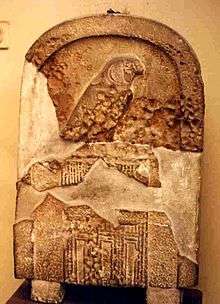 |
Greek form: Uenéphes (after his Gold name In-nebw); His name and titulary appear on the Palermo Stone. His tomb was later thought to be the legendary tomb of Osiris. | 54 years[16] |
| Djet |  |
Greek form: Usapháis. | 10 years[17] |
| Den |  |
Greek form: Kénkenes (after the ramesside diction of his birthname: Qenqen[18]). First pharaoh depicted wearing the double crown of Egypt, first pharaoh with a full niswt bity-name. | 42 years[17] |
| Anedjib |  |
Greek form: Miebidós. Known for his ominous nebwy-title.[19] | 10 years |
| Semerkhet | 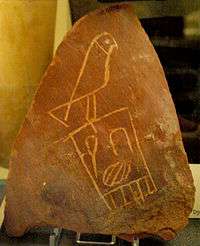 |
Greek form: Semempsés. First Egyptian ruler with a fully developed Nebty name. His complete reign is preserved on the Cairo stone. | 8½ years[17] |
| Qa'a | |
Greek form: Bienéches. Ruled very long, his tomb is the last one with subsidiary tombs. | 34 years |
| Sneferka |  |
Very short reign, correct chronological position unknown. | c. 2900 BC |
| Horus Bird |  |
Very short reign, correct chronological position unknown. | c. 2900 BC |
Second Dynasty
| Name | Image | Comments | Dates |
|---|---|---|---|
| Hotepsekhemwy[20] |  |
Manetho names him Boëthos and claims that under this ruler an earthquake killed many people. | 15 years |
| Nebra[21] |  |
Greek form: Kaíechós (after the ramesside cartouche name Kakaw). First ruler who uses the sun-symbol in his royal name, could be identical to king Weneg. | 14 years |
| Nynetjer[22] |  |
Greek form: Binóthris. May have divided Egypt between his successors, allegedly allowed women to rule like pharaohs. | 43–45 years |
| Weneg-Nebty[23] |  |
Greek form: Ougotlas/Tlás. Could be an independent ruler or the same as Peribsen, Sekhemib-Perenmaat or Raneb. | |
| Senedj[24] |  |
Greek form: Sethenes. Possibly the same person as Peribsen. This, however, is highly disputed.[25] | |
| Seth-Peribsen |  |
Used a Seth-animal above his serekh rather than an Horus falcon. He promoted the sun-cult in Egypt and reduced the powers of officials, nomarchs and palatines. Some scholars believe that he ruled over a divided Egypt.[26] | |
| Sekhemib-Perenmaat |  |
Could be the same person as Seth-Peribsen.[27] | |
| Neferkara I |  |
Greek form: Néphercherés. Known only from ramesside king lists, not archaeologically attested. | |
| Neferkasokar | |
Greek form: Sesóchris. Known only from ramesside king lists, not archaeologically attested. Old Kingdom legends claim that this ruler saved Egypt from a long lasting drought.[28] | |
| Hudjefa I |  |
Known only from ramesside king lists, his "name" is actually a paraphrase pointing out that the original name of the king was already lost in ramesside times. | |
| Khasekhem(wy)[29][30] |  |
Greek form: Chenerés. May have reunified Egypt after a period of trouble, his serekh name is unique for presenting both Horus and Set. |
Old Kingdom
Third Dynasty
| Name | Image | Comments | Dates |
|---|---|---|---|
| Djoser[31][32] |  |
Greek form: Tosórthros. Commissioned the first Pyramid in Egypt, created by chief architect and scribe Imhotep. | 19 or 28 years c. 2670 BC. |
| Sekhemkhet[33] |  |
Greek form: Tyréis (after the ramesside cartouche name for Sekhemkhet, Teti). In the necropolis of his unfinished step pyramid, the remains of a 2-year old infant were found.[34] | 2649–2643 |
| Sanakht |  |
Greek form: Necheróphes. Could be the same as Nebka, this is disputed amongst scholars. | c. 2650 |
| Khaba |  |
Possibly built an unfinished step pyramid, could be identical with Huni. | 2643–2637 |
| Huni[35] |  |
Greek form: Áches. Could be the same as Qahedjet or Khaba. Possibly built an unfinished step pyramid and several cultic pyramids throughout Egypt. Huni was for a long time credited with the building of the pyramid of Meidum. This, however, is disproved by New Kingdom graffitos which praise king Snofru, not Huni. | 2637–2613 |
Fourth Dynasty
| Name | Image | Comments | Dates |
|---|---|---|---|
| Sneferu |  | Greek form: Sóris. Reigned 48 years, giving him enough time to build the Meidum Pyramid, the Bent Pyramid and the Red Pyramid. Some scholars believe that he was buried in the Red Pyramid. Long time it was thought that the Meidum Pyramid was not Snofru's work, but that of king Huni. Ancient Egyptian documents describe Snofru as a pious, generous and even accostable ruler.[36] | |
| Khufu |  | Greek form: Cheops and Suphis. Built the Great pyramid of Giza. Khufu is depicted as a cruel tyrant by ancient Greek authors, Ancient Egyptian sources however describe him as a generous and pious ruler. He is the main protagonist of the famous Westcar Papyrus. The first imprinted papyri originate from Khufu's reign, which may have made ancient Greek authors believe that Khufu wrote books in attempt to praise the gods. | |
| Djedefre |  | Greek form: Rátoises. Some scholars believe he created the Great Sphinx of Giza as a monument for his deceased father. He also created a pyramid at Abu Rawash. However, this pyramid is no longer intact as it is believed the Romans recycled the materials it was made from. | |
| Khafre |  | Greek form: Chéphren and Suphis II. His pyramid is the second largest in Giza. Some scholars prefer him as the creator of the Great Sphinx before Djedefra. Ancient Greek authors describe Khafra as likewise cruel as Khufu. | |
| Baka/Bauefrê |  | Greek form: Bikheris. Could be the owner of the Unfinished Northern Pyramid of Zawyet el'Aryan. | |
| Menkaure | 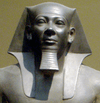 | Greek form: Menchéres. His pyramid is the third and smallest in Giza. A legend claims that his only daughter died due an illness and Menkaura buried her in a golden coffin in shape of a cow. | |
| Shepseskaf |  | Greek form: Seberchéres. Owner of the Mastabat el-Fara'un. | |
| Thamphthis | – | According to Manetho the last king of the 4th dynasty. He is not archaeologically attested and thus possibly fictional. | — |
Fifth Dynasty
The Fifth Dynasty ruled from 2498 to 2345 BC.
| Name | Image | Comments | Dates |
|---|---|---|---|
| Userkaf |  |
Buried in a pyramid in Saqqara. Built the first solar temple at Abusir. | |
| Sahure |  |
Moved the royal necropolis to Abusir, where he built his pyramid. | |
| Neferirkare Kakai |  |
Son of Sahure, born with the name Ranefer | |
| Neferefre |  |
Son of Neferirkare | |
| Shepseskare |  |
Reigned most likely after Neferefre and for only a few months, possibly a son of Sahure.[37] | |
| Nyuserre Ini |  |
Brother to Neferefre, built extensively in the Abusir necropolis. | |
| Menkauhor Kaiu |  |
Last pharaoh to build a sun temple | |
| Djedkare Isesi |  |
Effected comprehensive reforms of the Egyptian administration. Enjoyed the longest reign of his dynasty, with likely more than 35 years on the throne. | |
| Unas |  |
The Pyramid of Unas is inscribed with the earliest instance of the pyramid texts | |
Sixth Dynasty
The Sixth Dynasty ruled from 2345 to 2181 BC.
| Name | Image | Comments | Dates |
|---|---|---|---|
| Teti |  |
According to Manetho, he was murdered. | |
| Userkare |  |
Reigned 1 to 5 years, may have usurped the throne at the expense of Teti | |
| Meryre Pepi I |  |
— | |
| Merenre Nemtyemsaf I | 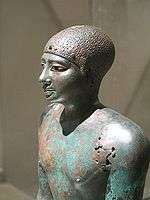 |
— | |
| Neferkare Pepi II |  |
Possibly the longest reigning monarch of human history with 94 years on the throne. Alternatively, may have reigned "only" 64 years. | |
| Neferka | Only mentioned in the Oxford Encyclopedia of Ancient Egypt. Reigned during Pepi II; was possibly his son or co-ruler. | | |
| Merenre Nemtyemsaf II[38] |  |
Short lived pharaoh, possibly an aged son of Pepi II. | |
| Neitiqerty Siptah |  |
Identical with Netjerkare. This male king gave rise to the legendary queen Nitocris of Herodotus and Manetho.[39] Sometimes classified as the first king of the combined 7th/8th Dynasties. | Short reign: c. 2184–2181 BC |
First Intermediate Period
The First Intermediate Period (2181–2060 BC) is a period of disarray and chaos between the end of the Old Kingdom and the advent of the Middle Kingdom.
The Old Kingdom rapidly collapsed after the death of Pepi II. He had reigned for more than 64 and likely up to 94 years, longer than any monarch in history. The latter years of his reign were marked by inefficiency because of his advanced age. The union of the Two Kingdoms fell apart and regional leaders had to cope with the resulting famine.
The kings of the 7th and 8th Dynasties, who represented the successors of the 6th Dynasty, tried to hold onto some power in Memphis but owed much of it to powerful nomarchs. After 20 to 45 years, they were overthrown by a new line of pharaohs based in Herakleopolis Magna. Some time after these events, a rival line based at Thebes revolted against their nomial Northern overlords and united Upper Egypt. Around 2055 BC, Mentuhotep II, the son and successor of pharaoh Intef III defeated the Herakleopolitan pharaohs and reunited the Two Lands, thereby starting the Middle Kingdom.
Seventh and Eighth Dynasties (combined)
The Seventh and Eighth Dynasties ruled for approximately 20–45 years. They comprise numerous ephemeral kings reigning from Memphis over a possibly divided Egypt and, in any case, holding only limited power owing to the effectively feudal system into which the administration had evolved. The list below is based on the Abydos King List dating to the reign of Seti I and taken from Jürgen von Beckerath's Handbuch der ägyptischen Königsnamen[40] as well as from Kim Ryholt's latest reconstruction of the Turin canon, another king list dating to the Ramesside Era.[41]
| Name | Image | Comments | Dates |
|---|---|---|---|
| Menkare |  |
Likely attested by a relief fragment from the tomb of queen Neit.[42][43][44] | |
| Neferkare II |  |
||
| Neferkare (III) Neby |  |
Attested by inscriptions in the tomb of his mother Ankhesenpepi, started the construction of a pyramid in Saqqara. | |
| Djedkare Shemai |  |
||
| Neferkare (IV) Khendu |  |
||
| Merenhor |  |
||
| Neferkamin |  |
||
| Nikare |  |
Possibly attested by a cylinder-seal. | |
| Neferkare (V) Tereru |  |
||
| Neferkahor |  |
Attested by a cylinder seal. | |
| Neferkare (VI) Pepiseneb |  |
||
| Neferkamin Anu |  |
||
| Qakare Ibi |  |
Built a pyramid at Saqqara inscribed with the last known instance of the Pyramid Texts | 2169–2167 BC |
| Neferkaure |  |
Attested by one to three decrees from the temple of Min at Coptos. | 2167–2163 BC |
| Neferkauhor Khuwihapi |  |
Attested by eight decrees from the temple of Min and an inscription in the tomb of Shemay. | 2163–2161 BC |
| Neferirkare |  |
Possibly to be identified with horus Demedjibtawy, in which case he is attested by a decree from the temple of Min. | 2161–2160 BC |
Ninth Dynasty
The Ninth Dynasty[45] ruled from 2160 to 2130 BC. The Turin King List has 18 kings reigning in the Ninth and Tenth Dynasties. Of these, twelve names are missing and four are partial.[45]
| Name | Image | Comments | Dates |
|---|---|---|---|
| Meryibre Khety I (Acthoes I) |  |
Manetho states that Achthoes founded this dynasty. | 2160–? |
| — | - | ? | |
| Neferkare VII | - | ? | |
| Nebkaure Khety II (Acthoes II) |  |
- | ? |
| Senenh— or Setut | - | ? | |
| — | - | ? | |
| Mery— | - | ? | |
| Shed— | - | ? | |
| H— | - | ? |
Tenth Dynasty
The Tenth Dynasty was a local group that held sway over Lower Egypt that ruled from 2130 to 2040 BC.
| Name | Image | Comments | Dates |
|---|---|---|---|
| Meryhathor |  |
— | 2130–? |
| Neferkare VIII | — | ? | |
| Wahkare Khety (Acthoes III) | 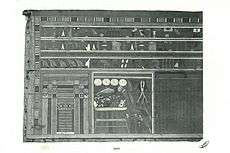 |
— | ? |
| Merykare |  |
— | ?–2040 |
Eleventh Dynasty
The Eleventh Dynasty was a local group with roots in Upper Egypt that ruled from 2134 to 1991 BC. The 11th dynasty originated from a dynasty of Theban nomarchs serving kings of the 8th, 9th or 10th dynasty.
| Name | Image | Comments | Dates |
|---|---|---|---|
| Intef the Elder Iry-pat |  |
Theban nomarch serving an unnamed king, later considered a founding figure of the 11th Dynasty. | — |
The successors of Intef the Elder, starting with Mentuhotep I, became independent from their northern overlords and eventually conquered Egypt under Mentuhotep II.
| Name | Image | Comments | Dates |
|---|---|---|---|
| Mentuhotep I Tepy-a |  |
Nominally a Theban nomarch but may have ruled independently. | |
| Sehertawy Intef I |  |
First member of the dynasty to claim a Horus name. | |
| Wahankh Intef II |  |
Conquered Abydos and its nome. | |
| Nakhtnebtepnefer Intef III |  |
Conquered Asyut and possibly moved further North up to the 17th nome.[46] | |
Middle Kingdom
The Middle Kingdom (2060–1802 BC) is the period from the end of the First Intermediate Period to the beginning of the Second Intermediate Period. In addition to the Twelfth Dynasty, some scholars include the Eleventh, Thirteenth and Fourteenth Dynasties in the Middle Kingdom. The Middle Kingdom can be noted for the expansion of trade outside of the kingdom that occurred during this time. This opening of trade eventually led to the downfall of the Middle Kingdom, induced by an invasion from the Hyksos.
Eleventh Dynasty continued
The second part of the Eleventh Dynasty is considered to be part of the Middle Kingdom of Egypt.
| Name | Image | Comments | Dates |
|---|---|---|---|
| Nebhepetre Mentuhotep II[47] |  |
Gained all Egypt c. 2015 BC, Middle Kingdom begins. | |
| Sankhkare Mentuhotep III[48] |  |
Commanded the first expedition to Punt of the Middle Kingdom | |
| Nebtawyre Mentuhotep IV[49] |  |
Obscure pharaoh absent from later king lists; tomb unknown. May have been overthrown by his vizier and successor Amenemhat I. | |
Enigmatic kings, only attested in Lower Nubia
| Name | Image | Comments | Dates |
|---|---|---|---|
| Segerseni[50] |  |
Obscure pharaoh absent from later king lists; tomb unknown. Only attested in Lower Nubia, most likely an usurper at the end of the Eleventh Dynasty or early Twelfth Dynasty. | |
| Qakare Ini[50] | |
Obscure pharaoh absent from later king lists; tomb unknown. Only attested in Lower Nubia, most likely an usurper at the end of the Eleventh Dynasty or early Twelfth Dynasty. | |
| Iyibkhentre[50] |  |
Obscure pharaoh absent from later king lists; tomb unknown. Only attested in Lower Nubia, most likely an usurper at the end of the Eleventh Dynasty or early Twelfth Dynasty. |
Twelfth Dynasty
The Twelfth Dynasty ruled from 1991 to 1802 BC.
| Name | Image | Comments | Dates |
|---|---|---|---|
| Sehetepibre Amenemhat I[51][52] |  |
Seized power after overthrowing Mentuhotep IV. Died assassinated. | |
| Kheperkare Senusret I[53] (Sesostris I) |  |
Built the White Chapel | |
| Nubkaure Amenemhat II[54] |  |
— | |
| Khakheperre Senusret II[55] (Sesostris II) | 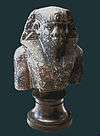 |
— | |
| Khakaure Senusret III[56] (Sesostris III) | |
Most powerful of the Middle Kingdom pharaohs. | |
| Nimaatre Amenemhat III[57] | |
— | |
| Maakherure Amenemhat IV[58] | -BritishMuseum-August19-08.jpg) |
Had a co-regency lasting at least 1 year based on an inscription at Konosso. | |
| Sobekkare Sobekneferu[59] |  |
A rare female ruler. | |
| Seankhibtawy Seankhibra | |
Enigmatic king of the Twelfth Dynasty. He was either a usurper or identical with one of the first three kings of the Dynasty. |
Second Intermediate Period
The Second Intermediate Period (1802–1550 BC) is a period of disarray between the end of the Middle Kingdom, and the start of the New Kingdom. It is best known as when the Hyksos, whose reign comprised the Fifteenth, made their appearance in Egypt.
The Thirteenth Dynasty was much weaker than the Twelfth Dynasty, and was unable to hold onto the two lands of Egypt. Either at the start of the dynasty, c. 1805 BC or toward the middle of it in c. 1710 BC, the provincial ruling family in Xois, located in the marshes of the eastern Delta, broke away from the central authority to form the Canaanite Fourteenth Dynasty.
The Hyksos made their first appearance during the reign of Sobekhotep IV, and around 1720 BC took control of the town of Avaris (the modern Tell el-Dab'a/Khata'na), conquering the kingdom of the 14th dynasty. Then, some time around 1650 BC the Hyksos, perhaps led by Salitis the founder of the Fifteenth Dynasty, conquered Memphis, thereby terminating the 13th dynasty. The power vacuum in Upper Egypt resulting from the collapse of the 13th dynasty allowed the 16th dynasty to declare its independence in Thebes, only to be overrun by the Hyksos kings shortly thereafter.
Subsequently, as the Hyksos withdrew from Upper Egypt, the native Egyptian ruling house in Thebes set itself up as the Seventeenth Dynasty. This dynasty eventually drove the Hyksos back into Asia under Seqenenre Tao, Kamose and finally Ahmose, first pharaoh of the New Kingdom.
Thirteenth Dynasty
The Thirteenth Dynasty (following the Turin King List) ruled from 1802 to around 1649 BC and lasted 153 or 154 years according to Manetho. This table should be contrasted with Known kings of the 13th Dynasty.
| Name | Image | Comments | Dates |
|---|---|---|---|
| Sekhemre Khutawy Sobekhotep I |  |
Founded the 13th Dynasty. His reign is well attested. Referred to as Sobekhotep I in dominant hypothesis, known as Sobekhotep II in older studies | 1802–1800 BC[60] |
| Sonbef |  |
Perhaps a brother of Sekhemre Khutawy Sobekhotep and son of Amenemhat IV[60] | 1800–1796 BC[60] |
| Nerikare |  |
1796 BC | |
| Sekhemkare Amenemhat V |  |
Ruled for 3 to 4 years[60] | 1796–1793 BC[60] |
| Ameny Qemau |  |
Buried in his pyramid in south Dashur | 1795–1792 BC |
| Hotepibre Qemau Siharnedjheritef |  |
Also called Sehotepibre | 1792–1790 BC |
| Iufni | Only attested on the Turin canon | Very short reign, possibly c. 1790 – 1788 BC[60] | |
| Seankhibre Amenemhet VI |  |
— | 1788–1785 BC |
| Semenkare Nebnuni |  |
— | 1785–1783 BC[60] or 1739 BC[61] |
| Sehetepibre Sewesekhtawy |  |
— | 1783–1781 BC[60] |
| Sewadjkare | Known only from the Turin canon | ||
| Nedjemibre | Known only from the Turin canon | 7 months, 1780 BC[60] or 1736 BC[61] | |
| Khaankhre Sobekhotep |  |
Referred to as Sobekhotep II in dominant hypothesis, known as Sobekhotep I in older studies | Reigned c. 3 years, 1780–1777 BC[60] |
| Renseneb | 4 months | 1777 BC[60] | |
| Awybre Hor I |  |
Famous for his intact tomb treasure and Ka statue | Reigned 1 year and 6 months, 1777–1775 BC[60] |
| Sekhemrekhutawy Khabaw |  |
Possibly a son of Hor Awibre | Estimated reign 3 years, 1775–1772 BC[60] |
| Djedkheperew |  |
Possibly a son of Hor Awibre and brother of Khabaw, previously identified with Khendjer | Estimated reign 2 years, 1772–1770 BC[60] |
| Sebkay |  |
Possibly two kings, Seb and his son Kay.[60] | |
| Sedjefakare |  |
A well known king attested on numerous stelas and other documents. | 5 to 7 years or 3 years, 1769–1766 BC[60] |
| Khutawyre Wegaf |  |
Founder of the dynasty in old studies | c. 1767 BC |
| Khendjer | 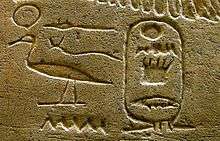 |
Possibly the first semitic pharaoh, built a pyramid at Saqqara | Minimum 4 years and 3 months c. 1765 BC |
| Imyremeshaw | |
Attested by two colossal statues | Reigned less than 10 years, starting 1759 BC[60] or 1711 BC.[62] |
| Sehetepkare Intef IV |  |
— | ? |
| Seth Meribre |  |
— | ? |
| Sekhemresewadjtawy Sobekhotep III |  |
4 years and 2 months | c. 1755–1751 BC |
| Khasekhemre Neferhotep I |  |
11 years | 1751–1740 BC |
| Menwadjre Sihathor | 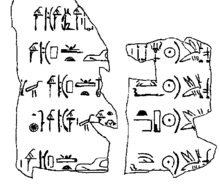 |
Ephemeral coregent with his brother Neferhotep I, may not have reigned independently. | 1739 BC[60] |
| Khaneferre Sobekhotep IV |  |
10 or 11 years | 1740–1730 BC |
| Merhotepre Sobekhotep V |  |
— | c. 1730 BC |
| Khahotepre Sobekhotep VI |  |
4 years 8 months and 29 days | c. 1725 BC |
| Wahibre Ibiau |  |
10 years and 8 months | 1725–1714 BC or 1712–1701 BC[60] |
| Merneferre Ay I |  |
Longest reigning king of the dynasty | 23 years, 8 months and 18 days, 1701–1677 BC[60] or 1714–1691 BC |
| Merhotepre Ini |  |
Possibly a son of his predecessor | 2 Years 3 or 4 Months and 9 days, 1677–1675 BC[60] or 1691–1689 BC |
| Sankhenre Sewadjtu | Attested only on the Turin canon | 3 years and 2–4 months, 1675–1672 BC[60] | |
| Mersekhemre Ined |  |
May be the same person as Neferhotep II | 3 years, 1672–1669 BC[60] |
| Sewadjkare Hori | 5 years | ? | |
| Merkawre Sobekhotep VII | |
2 years and 6 months [60] | 1664–1663 BC[60] |
| Seven kings | Names lost in a lacuna of the Turin canon [60] | 1663 BC –?[60] | |
| Mer[…]re | — | ? | |
| Merkheperre |  |
— | Some time between 1663 BC and 1649 BC [60] |
| Merkare | — | Some time between 1663 BC and 1649 BC [60] | |
| Name lost | — | ? | |
| Sewadjare Mentuhotep V | 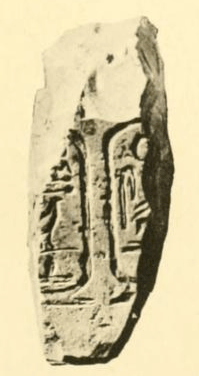 |
— | c. 1655 BC[60] |
| […]mosre | — | ? | |
| Ibi […]maatre | — | ? | |
| Hor[…] […]webenre | — | ? | |
| Se...kare | ? | ? | |
| Seheqenre Sankhptahi |  |
May be the son of his predecessor | ? |
| ...re | ? | ? | |
| Se...enre | ? | ?–1649 BC [60] |
The position of the following kings is uncertain:
| Name | Image | Comments | Dates |
|---|---|---|---|
| Dedumose I | 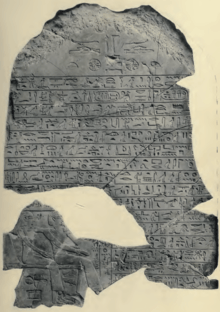 |
Possibly a king of the 16th dynasty | c. 1654 |
| Dedumose II | 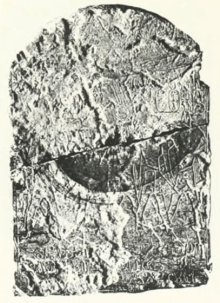 |
Possibly a king of the 16th dynasty | ? |
| Sewahenre Senebmiu |  |
Late 13th dynasty. | After 1660 BC.[60] |
| Snaaib |  |
Possibly a king of the Abydos Dynasty | ? |
| Mershepsesre Ini II |  |
Late 13th dynasty. | ? |
Fourteenth Dynasty
The Fourteenth Dynasty was a local group from the eastern Delta, based at Avaris,[63] that ruled from either from 1805 BC or c. 1710 BC until around 1650 BC. The dynasty comprised many rulers with West Semitic names and is thus believed to have been Canaanite in origin. It is here given as per Ryholt, however this reconstruction of the dynasty is heavily debated with the position of the five kings preceding Nehesy highly disputed.
| Name | Image | Comments | Dates |
|---|---|---|---|
| Yakbim Sekhaenre |  |
Chronological position uncertain, here given as per Ryholt[63] | 1805–1780 BC |
| Ya'ammu Nubwoserre |  |
Chronological position uncertain, here given as per Ryholt[63] | 1780–1770 BC |
| Qareh Khawoserre[63] |  |
Chronological position uncertain, here given as per Ryholt[63] | 1770–1760 BC |
| 'Ammu Ahotepre[63] |  |
Chronological position uncertain, here given as per Ryholt[63] | 1760–1745 BC |
| Sheshi[64] | .jpg) |
Chronological position, duration of reign and extend of rule uncertain, here given as per Ryholt.[63] Alternatively, he could be an early Hyksos king, a Hyksos ruler of the second part of the 15th Dynasty or a vassal of the Hyksos. | 1745–1705 BC |
| Nehesy |  |
Short reign, perhaps a son of Sheshi [63] | c. 1705 |
| Khakherewre | - | ? | |
| Nebefawre | - | c. 1704 | |
| Sehebre | Possibly identifiable with Wazad or Sheneh[60] | - | |
| Merdjefare |  |
Possibly identifiable with Wazad or Sheneh[60] | c. 1699 |
| Sewadjkare III | - | ? | |
| Nebdjefare | - | c. 1694 | |
| Webenre | - | ? | |
| — | - | ? | |
| Djefare? | - | ? | |
| Webenre | c. 1690 | ||
| Nebsenre[63] |  |
Attested by a jar bearing his prenomen | At least 5 months of reign, some time between 1690 BC and 1649 BC |
| Sekheperenre[63] |  |
Attested by a single scarab seal | 2 months, some time between 1690 BC and 1649 BC |
| Anati Djedkare[63] | Only known from the Turin canon | ||
| Bebnum[63] | Only known from the Turin canon | ||
| 'Apepi[63] | Possibly attested as a king's son by 5 scarabs-seals | ||
The position and identity of the following pharaohs is uncertain:
| Name | Image | Comments | Dates |
|---|---|---|---|
| Nuya[60] | Attested by a scarab-seal | ||
| Wazad[60] |  |
May be identifiable with Sehebre or Merdjefare | c. 1700 BC ? |
| Sheneh[60] |  |
May be identifiable with Sehebre or Merdjefare | |
| Shenshek[60] |  |
Attested by a scarab-seal | |
| Khamure[60] |  |
||
| Yakareb[60] |  |
||
| Yaqub-Har[64] |  |
May belong to the 14th dynasty, the 15th dynasty or be a vassal of the Hyksos. | 17th–16th centuries BC |
The Turin King List provides additional names, none of which are attested beyond the list.
Fifteenth Dynasty
The Fifteenth Dynasty arose from among the Hyksos people who emerged from the Fertile Crescent to establish a short-lived governance over much of the Nile region, and ruled from 1674 to 1535 BC.
| Name | Image | Comments | Dates |
|---|---|---|---|
| Semqen |  |
Chronological position uncertain. | 1649 BC – ? |
| 'Aper-'Anat |  |
Chronological position uncertain. | |
| Sakir-Har | - | ? | |
| Khyan | 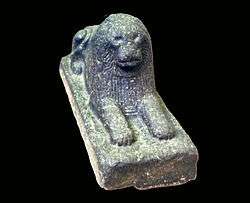 |
Apex of the Hyksos' power, conquered Thebes toward the end of his reign | 30–40 years |
| Apepi | 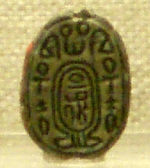 |
- | 40 years or more |
| Khamudi |  |
- | 1555–1544 |
Abydos Dynasty
The Second Intermediate Period may include an independent dynasty reigning over Abydos from c. 1650 BC until 1600 BC.[65][66][67] Four attested kings may be tentatively attributed to the Abydos Dynasty, and they are given here without regard for their (unknown) chronological order:
| Name | Image | Comments | Dates |
|---|---|---|---|
| Sekhemraneferkhau Wepwawetemsaf |  |
May belong to the late 16th Dynasty[68] | |
| Sekhemrekhutawy Pantjeny |  |
May belong to the late 16th Dynasty[68] | |
| Menkhaure Snaaib |  |
May belong to the late 13th Dynasty.[69][70][71] | |
| Woseribre Senebkay |  |
Tomb discovered in 2014. Perhaps identifiable with a Woser[...]re of the Turin canon. | |
Sixteenth Dynasty
The Sixteenth Dynasty was a native Theban dynasty emerging from the collapse of the Memphis-based 13 th dynasty c. 1650 BC and finally conquered by the Hyksos 15th dynasty c. 1580 BC. The 16th dynasty held sway over Upper-Egypt only.
| Name | Image | Comments | Dates |
|---|---|---|---|
| — | Name of the first king is lost here in the Turin King List, and cannot be recovered | ||
| Djehuti Sekhemresementawy |  |
– | 3 years |
| Sobekhotep VIII Sekhemreseusertawy |  |
– | 16 years |
| Neferhotep III Sekhemresankhtawy |  |
– | 1 year |
| Mentuhotepi Seankhenre |  |
May be a king of the 17th Dynasty[70] | 1 year |
| Nebiryraw I Sewadjenre |  |
– | 26 years |
| Nebiryraw II Neferkare? |  |
– | |
| Semenre |  |
– | |
| Bebiankh Seuserenre |  |
– | 12 years |
| Dedumose I Djedhotepre |  |
May be a king of the 13th Dynasty[70] | |
| Dedumose II Djedneferre |  |
– | |
| Montuemsaf Djedankhre |  |
– | |
| Merankhre Mentuhotep VI |  |
– | |
| Senusret IV Seneferibre |  |
– | |
| Sekhemre Shedwast | – | ||
The 16th Dynasty may also have comprised the reigns of pharaohs Sneferankhre Pepi III[72] and Nebmaatre. Their chronological position is uncertain.[69][70]
Seventeenth Dynasty
The Seventeenth Dynasty was based in Upper Egypt and ruled from 1650 to 1550 BC:
| Name | Image | Comments | Dates |
|---|---|---|---|
| Sekhemrewahkhaw Rahotep |  |
- | |
| Sekhemre Wadjkhaw Sobekemsaf I | -BritishMuseum-August19-08.jpg) |
Reigned at least 7 years | - |
| Sekhemre Shedtawy Sobekemsaf II |  |
His tomb was robbed and burned during the reign of Ramses IX | - |
| Sekhemre-Wepmaat Intef V |  |
- | - |
| Nubkheperre Intef VI |  |
Reigned more than 3 years | - |
| Sekhemre-Heruhirmaat Intef VII |  |
- | - |
| Senakhtenre Ahmose | 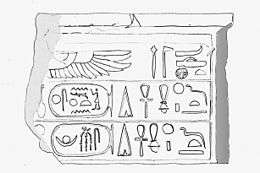 |
- | |
| Seqenenre Tao | |
Died in battle against the Hyksos. | |
| Wadjkheperre Kamose |  |
|
The early 17th Dynasty may also have comprised the reign of a pharaoh Nebmaatre, whose chronological position is uncertain.[60]
New Kingdom
The New Kingdom (1550–1077 BC) is the period covering the Eighteenth, Nineteenth, and Twentieth dynasty of Egypt, from the 16th to the 11th century BC, between the Second Intermediate Period, and the Third Intermediate Period.
Through military dominance abroad, the New Kingdom saw Egypt's greatest territorial extent. It expanded far into Nubia in the south, and held wide territories in the Near East. Egyptian armies fought with Hittite armies for control of modern-day Syria.
Three of the best known pharaohs of the New Kingdom are Akhenaten, also known as Amenhotep IV, whose exclusive worship of the Aten is often interpreted as the first instance of monotheism, Tutankhamun known for the discovery of his nearly intact tomb, and Ramesses II who attempted to recover the territories in modern Israel/Palestine, Lebanon and Syria that had been held in the Eighteenth Dynasty. His reconquest led to the Battle of Qadesh, where he led the Egyptian armies against the army of the Hittite king Muwatalli II.
Eighteenth Dynasty
The Eighteenth Dynasty ruled from c. 1550 to 1292 BC:
| Name | Image | Comments | Dates |
|---|---|---|---|
| Nebpehtire Ahmose I, Ahmosis I |  |
Brother and successor to Kamose, conquered north of Egypt from the Hyksos. | c. 1550–1525 BC; Radiocarbon date range for the start of his reign is 1570–1544 BC, the mean point of which is 1557 BC[73] |
| Djeserkare Amenhotep I | 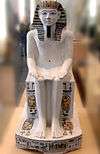 |
Son of Ahmose I. | 1541–1520 |
| Aakheperkare Thutmose I | 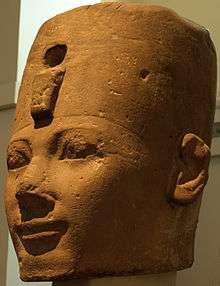 |
Father unknown, though possibly Amenhotep I. His mother is known to be Senseneb. Expanded Egypt's territorial extent during his reign. | 1520–1492 |
| Aakheperenre Thutmose II |  |
Son of Thutmose I. Grandson of Amenhotep I through his mother, Mutnofret. | 1492–1479 |
| Maatkare Hatshepsut | 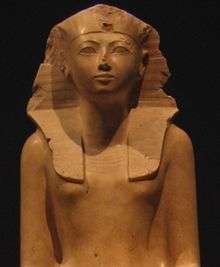 |
The second known female ruler of Egypt. May have ruled jointly with her nephew Thutmose III during the early part of her reign. Famous for her expedition to Punt documented on her famous Mortuary Temple at Deir el-Bahari. Built many temples and monuments. Ruled during the height of Egypt's Power. Was the daughter of Thutmose I and the Great Wife of her brother Thutmose II. | 1479–1458 |
| Menkheperre Thutmose III | |
Son of Thutmose II. May have ruled jointly with Hatshepsut, his aunt and step-mother, during the early part of her reign. Famous for his territorial expansion into Levant and Nubia. Under his reign, the Ancient Egyptian Empire was at its greatest extent. Ruled during the height of Egypt's Power. Late in his reign, he obliterated Hatshepsut's name and image from temples and monuments. | 1458–1425 |
| Aakheperrure Amenhotep II |  |
Son of Thutmose III. Ruled during the height of Egypt's Power. | 1425–1400 |
| Menkheperure Thutmose IV | .jpg) |
Famous for his Dream Stele. Son of Amenhotep II. Ruled during the height of Egypt's Power. | 1400–1390 |
| Nebmaatre Amenhotep III The Magnificent King |  |
Father of Akhenaten and grandfather of Tutankhamun. Ruled Egypt at the height of its power. Built many temples and monuments, including his enormous Mortuary Temple. Was the son of Thutmose IV. | 1390–1352 |
| Neferkheperure-waenre Amenhotep IV/Akhenaten | |
Founder of the Amarna Period in which he changed the state religion from the polytheistic Ancient Egyptian religion to the Monotheistic Atenism, centered around the worship of the Aten, an image of the sun disc. He moved the capital to Akhetaten. Was the second son of Amenhotep III. He changed his name from Amenhotep (Amun is pleased) to Akhenaten (Effective for the Aten) to reflect his religion change. | 1352–1334 |
| Ankhkheperure Smenkhkare |  |
Ruled jointly with Akhenaten during the later years of his reign. Unknown if Smenkhare ever ruled in their own right. Identity and even the gender of Smenkhare is uncertain. Some suggest he may have been the son of Akenhaten, possibly the same person as Tutankhamun, other speculate Smenkhare may have been Nefertiti or Meritaten. May have been succeeded by or identical with a female Pharaoh named Neferneferuaten. | 1334–1333 |
| Nebkheperure Tutankhaten/Tutankhamun | .jpg) |
Commonly believed to be the son of Akhenaten, most likely reinstated the Polytheistic Ancient Egyptian religion. His name change from Tutankhaten to Tutankhamun reflects the change in religion from the Monotheistic Atenism to the classic religion, of which Amun is a major deity. He is thought to have taken the throne at around age eight or nine and to have died around age eighteen or nineteen, giving him the nickname "The Boy King." | 1333–1324 |
| Kheperkheperure Ay |  |
Was Grand Vizier to Tutankhamun and an important official during the reigns of Akhenaten and Smenkhkare. Possibly the brother of Tiye, Great Wife of Amenhotep III, and also possibly father of Nefertiti, Great Wife of Akhenaten. Believed to be born into nobility, but not royalty. Succeeded Tutankhamun due to his lack of an heir. | 1324–1320 |
| Djeserkheperure-setpenre Horemheb |  |
Born a Commoner. Was a General during the Amarna Period. Obliterated Images of the Amarna Pharaohs and destroyed and vandalized buildings and monuments associated with them. Succeeded Ay despite Nakhtmin being the intended heir. | 1320–1292 |
Nineteenth Dynasty
The Nineteenth Dynasty ruled from 1292 to 1186 BC and includes one of the greatest pharaohs: Rameses II the Great:
| Name | Image | Comments | Dates |
|---|---|---|---|
| Menpehtire Ramesses I[74] |  |
Of non-royal birth. Succeeded Horemheb due to his lack of an heir. | 1292–1290 |
| Menmaatre Seti I |  |
Regained much of the territory that was lost under the reign of Akhenaten. | 1290–1279 |
| Usermaatre-setpenre Ramesses II the Great |  |
Continued expanding Egypt's territory until he reached a stalemate with the Hittite Empire at the Battle of Kadesh in 1275 BC, after which the famous Egyptian–Hittite peace treaty was signed in 1258 BC. | 1279–1213 |
| Banenre Merenptah[75] |  |
Thirteenth son of Ramesses II. | 1213–1203 |
| Menmire-setpenre Amenmesse |  |
Most likely an usurper to the throne. Possibly ruled in opposition to Seti II. Suggested son of Merneptah. | 1203–1200 |
| Userkheperure Seti II[76] |  |
Son of Merneptah. May have had to overcome a contest by Amenmesse before he could solidify his claim to the throne. | 1203–1197 |
| Sekhaenre/Akhenre Merenptah Siptah[77] |  |
Possibly son of Seti II or Amenmesse, ascended to throne at a young age. | 1197–1191 |
| Satre-merenamun Tausret |  |
Probably the wife of Seti II. Also known as Twosret or Tawosret. | 1191–1190 |
Twentieth Dynasty
The Twentieth Dynasty ruled from 1190 to 1077 BC:
| Name | Image | Comments | Dates |
|---|---|---|---|
| Userkhaure Setnakhte |  |
Not related to Seti II, Siptah, or Tausret. May have usurped the throne from Tausret. Did not recognize Siptah or Tausret as legitimate rulers. Possibly a member of a minor line of the Ramesside royal family. Also called Setnakt. | 1190–1186 |
| Usermaatre-meryamun Ramesses III |  |
Son of Setnakhte. Fought the Sea Peoples in 1175 BC. May have been assassinated. | 1186–1155 |
| User/Heqamaatre-setpenamun Ramesses IV | 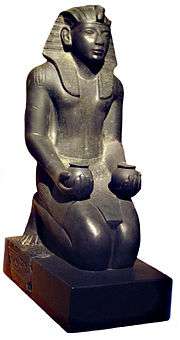 |
Son of Ramesses III. During his reign, Egyptian power started to decline. | 1155–1149 |
| Usermaatre-sekheperenre Ramesses V |  |
Son of Ramesses IV | 1149–1145 |
| Nebmaatre-meryamun Ramesses VI |  |
Son of Ramesses III. Brother of Ramesses IV. Uncle of Ramesses V. | 1145–1137 |
| Usermaatre-setpenre-meryamun Ramesses VII |  |
Son of Ramesses VI. | 1137–1130 |
| Usermaatre-akhenamun Ramesses VIII |  |
An obscure Pharaoh, who reigned only around a year. Identifiable with Prince Sethiherkhepeshef II. Son of Ramesses III. Brother of Ramesses IV and Ramesses VI. Uncle of Ramesses V and Ramesses VII. He is the sole Pharaoh of the Twentieth Dynasty whose tomb has not been found. | 1130–1129 |
| Neferkare-setpenre Ramesses IX |  |
Probably grandson of Ramesses III through his father, Montuherkhopshef. First cousin of Ramesses V and Ramesses VII. | 1129–1111 |
| Khepermaatre-setpenptah Ramesses X[78] |  |
A poorly documented Pharaoh, his reign was between 3 and 10 years long. His origins are completely uncertain. | 1111–1107 |
| Menmaatre-setpenptah Ramesses XI[79] |  |
Possibly the son of Ramesses X. During the second half of his reign, High Priest of Amun Herihor ruled over the south from Thebes, limiting his power to Lower (Northern) Egypt. He was succeeded in the north by Smendes. | 1107–1077 |
Third Intermediate Period
The Third Intermediate Period (1077–664 BC) marked the end of the New Kingdom after the collapse of the Egyptian empire. A number of dynasties of Libyan origin ruled, giving this period its alternative name of the Libyan Period.
Twenty-first Dynasty
The Twenty-First Dynasty was based at Tanis and was a relatively weak group. Theoretically, they were rulers of all Egypt, but in practice their influence was limited to Lower Egypt. They ruled from 1069 to 943 BC
| Name | Image | Comments | Dates |
|---|---|---|---|
| Hedjkheperre-setpenre Nesbanebdjed I (Smendes I)[80] |  |
Married to Tentamun, probable daughter of Ramesses XI. | 1077–1051 |
| Neferkare Heqawaset Amenemnisu |  |
Obscure four-year reign. | 1051–1047 |
| Aakheperre Pasebakhenniut I (Psusennes I) |  |
Son of Pinedjem I, a High Priest of Amun. Ruled for 40 to 51 years. Famous for his intact tomb at Tanis. Known as "The Silver Pharaoh" due to the magnificent silver coffin he was buried in. One of the most powerful rulers of the Dynasty. | 1047–1001 |
| Usermaatre Amenemope |  |
Son of Psusennes I. | 1001–992 |
| Aakheperre Setepenre Osorkon (Osorkon the Elder) |  |
Son of Shoshenq A, Great Chief of the Meshwesh (Libya). Also known as Osochor. | 992–986 |
| Netjerikheperre-setpenamun Siamun-meryamun |  |
Unknown Origins. Built extensively for a third intermediate period Pharaoh. One of the most powerful rulers of the dynasty. | 986–967 |
| Titkheperure Pasebakhenniut II (Psusennes II) |  |
Son of Pinedjem II, a High Priest of Amun. | 967–943 |
Theban High Priests of Amun
Though not officially Pharaohs, the High Priests of Amun at Thebes were the de facto rulers of Upper Egypt during the Twenty-first and Twenty-second Dynasties, writing their names in cartouches and being buried in royal tombs.
| Name | Image | Comments | Dates |
|---|---|---|---|
| Herihor | 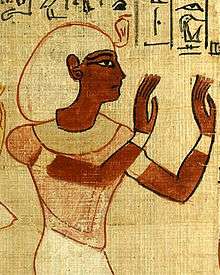 |
First High Priest of Amun to claim to be Pharaoh. He ruled in the south in Thebes, while Ramesses XI ruled from the north in Pi-Ramesses. | 1080–1074 |
| Piankh |  |
- | 1074–1070 |
| Pinedjem I |  |
Son of Piankh. Father of Psusennes I. | 1070–1032 |
| Masaharta | |
Son of Pinedjem I. | 1054–1045 |
| Djedkhonsuefankh | Son of Pinedjem I. | 1046–1045 | |
| Menkheperre |  |
Son of Pinedjem I. | 1045–992 |
| Nesbanebdjed II (Smendes II) |  |
Son of Menkheperre. | 992–990 |
| Pinedjem II |  |
Son of Menkheperre, Father of Psusennes II. | 990–976 |
| Pasebakhaennuit III (Psusennes III) | Possibly the same person as Psusennes II. Either he or Pinedjem II is generally considered to be the last High Priest of Amun to consider himself as a Pharaoh-like figure. | 976–943 |
Twenty-second Dynasty
The pharaohs of the Twenty-Second Dynasty were Libyans, ruling from around 943 to 728 BC:
| Name | Image | Comments | Dates |
|---|---|---|---|
| Hedjkheperre-setepenre Shoshenq I |  |
Son of Nimlot A, a brother of Osorkon the Elder and a Great Chief of the Meshwesh (Libya). | 943–922 |
| Sekhemkheperre Osorkon I |  |
Son of Shoshenq I. | 922–887 |
| Heqakheperre Shoshenq II | 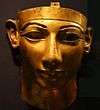 |
Obscure Pharaoh, possibly a usurper. | 887–885 |
| Tutkheperre Shoshenq IIb | Obscure Pharaoh, placement uncertain. | 880s | |
| Hedjkheperre Harsiese | An obscure rebel, at Thebes. | 880–860 | |
| Takelot I |  |
Son of Osorkon I. | 885–872 |
| Usermaatre-setepenamun Osorkon II |  |
Son of Takelot I. | 872–837 |
| Usermaatre-setepenre Shoshenq III |  |
- | 837–798 |
| Shoshenq IV | - | 798–785 | |
| Usermaatre-setepenre Pami |  |
- | 785–778 |
| Aakheperre Shoshenq V |  |
- | 778–740 |
| Usermaatre Osorkon IV | |
- | 740–720 |
Twenty-third Dynasty
The Twenty-Third Dynasty was a local group, again of Libyan origin, based at Herakleopolis and Thebes that ruled from 837 to c. 735 BC:
| Name | Image | Comments | Dates |
|---|---|---|---|
| Hedjkheperre-setpenre Takelot II |  |
Previously thought to be a 22nd Dynasty pharaoh, he is now known to be the founder of the 23rd | 837–813 |
| Usermaatre-setepenamun Pedubast |  |
A rebel—seized Thebes from Takelot II | 826–801 |
| Usermaatre-setepenamun Iuput I | Co-regent with Pedubast | 812–811 | |
| Usermaatre Shoshenq VI | Successor to Pedubast | 801–795 | |
| Usermaatre-setepenamun Osorkon III |  |
Son of Takelot II; recovered Thebes, then proclaimed himself king | 795–767 |
| Usermaatre-setpenamun Takelot III |  |
Co-reign with his father Osorkon III for the first five years of his reign. | 773–765 |
| Usermaatre-setpenamun Rudamun |  |
Younger son of Osorkon III and brother of Takelot III. | 765–762 |
Rudamun was succeeded in Thebes by a local ruler:
| Name | Image | Comments | Dates |
|---|---|---|---|
| Menkheperre Ini |  |
Reigned at Thebes only | 762–? |
Twenty-fourth Dynasty
The Twenty-fourth Dynasty was a short-lived rival dynasty located in the western Delta (Sais), with only two pharaohs ruling from 732 to 720 BC.
| Name | Image | Comments | Dates |
|---|---|---|---|
| Shepsesre Tefnakhte | _det.jpg) |
- | 732–725 |
| Wahkare Bakenrenef (Bocchoris) |  |
- | 725–720 |
Twenty-fifth Dynasty
Nubians invaded Lower Egypt and took the throne of Egypt under Piye although they already controlled Thebes and Upper Egypt in the early years of Piye's reign. Piye's conquest of Lower Egypt established the Twenty-fifth Dynasty which ruled until 656 BC.
| Name | Image | Comments | Dates |
|---|---|---|---|
| Usermaatre Piye |  |
King of Nubia; conquered Egypt in 20th year; full reign at least 24 years, possibly 30+ years | 744–714 according to Frédéric Payraudeau[81] |
| Djedkaure Shebitku |  |
Believed to be Shabaka's successor until the 2010s | 714–705 according to Frédéric Payraudeau[81] |
| Neferkare Shabaka |  |
Believed to be Shebitku's predecessor until the 2010s | 705–690 according to Frédéric Payraudeau[81] |
| Khuinefertemre Taharqa |  |
- | 690–664 |
| Bakare Tantamani | |
Lost control of Upper Egypt in 656 BC when Psamtik I extended his authority into Thebes in that year. | 664–653 |
They were ultimately driven back into Nubia, where they established a kingdom at Napata (656–590), and, later, at Meroë (590 BC – 4th century AD).
Late Period
The Late Period runs from around 664 to 332 BC, and includes periods of rule by native Egyptians and Persians.
Twenty-sixth Dynasty
The Twenty-sixth Dynasty ruled from around 664 to 525 BC.[82]
| Name | Image | Comments | Dates |
|---|---|---|---|
| Tefnakht II | Manetho's Stephinates. May have been a descendant of the Twenty-fourth Dynasty. The father of Necho I. | 685–678 BC | |
| Nekauba | Manetho's Nechepsos. His existence has been questioned. | 678–672 BC | |
| Menkheperre Nekau I (Necho I) |  |
Was killed by an invading Kushite force in 664 BC under Tantamani. Father of Psamtik I. | 672–664 BC |
The son and successor of Necho I, Psamtik I, managed to reunify Egypt and is generally regarded as the founder of the Twenty-sixth Dynasty.
| Name | Image | Comments | Dates |
|---|---|---|---|
| Wahibre Psamtik I (Psammetichus I) |  |
Reunified Egypt. Son of Necho I and father of Necho II. | 664–610 BC |
| Wehemibre Necho II (Necho II) |  |
Most likely the pharaoh mentioned in several books of the Bible. Son of Psamtik I and father of Psamtik II. | 610–595 BC |
| Neferibre Psamtik II (Psammetichus II) |  |
Son of Necho II and father of Apries. | 595–589 BC |
| Haaibre Wahibre (Apries) | 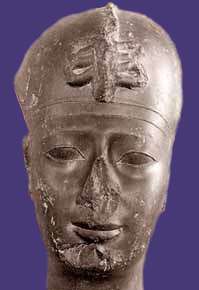 |
Fled Egypt after Amasis II (who was a general at the time) declared himself pharaoh following a civil war. Son of Psamtik II. | 589–570 BC |
| Khnemibre Ahmose II (Amasis II) | |
He was the last great ruler of Egypt before the Persian conquest. According to the Greek historian Herodotus, he was of common origins. Father of Psamtik III. | 570–526 BC |
| Ankhkaenre Psamtik III (Psammetichus III) |  |
Son of Amasis II. Ruled for about six months before being defeated by the Persians in the Battle of Pelusium and subsequently executed for attempting to revolt. | 526–525 BC |
Twenty-seventh Dynasty (First Persian period)
Egypt was conquered by the Persian Empire in 525 BC and constitutued a satrapy as part of this empire until 404 BC. The Achaemenid Shahanshahs were acknowledged as Pharaohs in this era, forming the 27th Dynasty:
| Name | Image | Comments | Dates |
|---|---|---|---|
| Cambyses (Cambyses II) |  |
Defeated Psamtik III at the Battle of Pelusium at 525 BC | 525–521 BC |
| Smerdis (Bardiya) | Son of Cyrus the Great | 522–521 BC | |
| Petubastis III[83] | |
A native Egyptian rebel in the Delta | 522/21–520 BC |
| Darius I the Great | .jpg) |
- | 521–486 BC |
| Xerxes I the Great |  |
- | 486–465 BC |
| Psammetichus IV[83] | A proposed native Egyptian rebel leader. Exact date uncertain. | possibly in the 480s BC | |
| Artabanus the Hyrcanian | - | 465–464 BC | |
| Artaxerxes I Longhand | 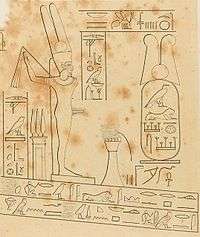 |
- | 464–424 BC |
| Xerxes II | claimant | 424–423 BC | |
| Sogdianus | claimant | 424–423 BC | |
| Darius II |  |
424–404 BC |
Twenty-eighth Dynasty
The Twenty-eighth Dynasty lasted only 6 years, from 404 to 398 BC, with one Pharaoh:
| Name | Image | Comments | Dates |
|---|---|---|---|
| Amyrtaeus |  |
Descendant of the Saite pharaohs of the Twenty-sixth Dynasty; led a successful revolt against the Persians. | 404–398 BC |
Twenty-ninth Dynasty
The Twenty-ninth Dynasty ruled from 398 to 380 BC:
| Name | Image | Comments | Dates |
|---|---|---|---|
| Baenre Nefaarud I |  |
Also known as Nepherites. Defeated Amyrtaeus in open battle and had him executed. | 399–393 BC |
| Khenemmaatre Hakor (Achoris) |  |
Son of Nefaarud I. | c. 392–c. 391 BC |
| Psammuthes |  |
Possibly dethroned Hakor for a year. | c. 391 BC |
| Hakor (restored) |  |
Retook the throne from Psammuthes. | c. 390–c. 379 BC |
| Nefaarud II | Was deposed and likely killed by Nectanebo I after ruling for only 4 months. Son of Hakor. | c. 379 BC |
Thirtieth Dynasty
The Thirtieth Dynasty ruled from 380 until Egypt once more came under Persian rule in 343 BC:
| Name | Image | Comments | Dates |
|---|---|---|---|
| Kheperkare Nekhtnebef (Nectanebo I) |  |
Also known as Nekhtnebef. Deposed and likely killed Nefaarud II, starting the last dynasty of native Egyptians. Father of Teos. | c. 379–c. 361 BC |
| Irimaatenre Djedher (Teos) | ._30th_Dynasty._From_the_Palace_of_Apries_at_Memphis%2C_Egypt._The_Petrie_Museum_of_Egyptian_Archaeology%2C_London.jpg) |
Co-regent with his father Nectanebo I from about 365 BC. Was overthrown by Nectanebo II with the aid of Agesilaus II of Sparta. | c. 361–c. 359 BC |
| Senedjemibre Nakhthorhebyt (Nectanebo II) |  |
Last native ruler of ancient Egypt[84] | c. 359–c. 342 BC |
Thirty-first Dynasty (Second Persian period)
Egypt again came under the control of the Achaemenid Persians. After the practice of Manetho, the Persian rulers from 343 to 332 BC are occasionally designated as the Thirty-first Dynasty:
| Name | Image | Comments | Dates |
|---|---|---|---|
| Artaxerxes III |  |
Egypt came under Persian rule for the second time | 343–338 BC |
| Artaxerxes IV Arses | Only reigned in Lower Egypt | 338–336 BC | |
| Khababash |  |
Rebel pharaoh who led an invasion in Nubia | 338–335 BC |
| Darius III |  |
Upper Egypt returned to Persian control in 335 BC | 336–332 BC |
Hellenistic Period
Argead Dynasty
The Macedonians under Alexander the Great ushered in the Hellenistic period with his conquest of Persia and Egypt. The Argeads ruled from 332 to 309 BC:
| Name | Image | Comments | Dates |
|---|---|---|---|
| Setepenre-meryamun Alexander III (Alexander the Great) | 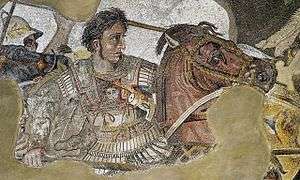 |
Macedon conquered Persia and Egypt | 332–323 BC |
| Philip III Arrhidaeus | |
Feeble-minded half-brother of Alexander III the Great | 323–317 BC |
| Haaibre Alexander IV | |
Son of Alexander III the Great and Roxana | 317–309 BC |
Ptolemaic Dynasty
The second Hellenistic dynasty, the Ptolemies, ruled Egypt from 305 BC until Egypt became a province of Rome in 30 BC (whenever two dates overlap, that means there was a co-regency). The most famous member of this dynasty was Cleopatra VII, who in modern times is known simply as Cleopatra who was successively the consort of Julius Caesar and after Caesar's death, of Mark Antony, and had children with both of them. Cleopatra strove to create a dynastic and political union between Egypt and Rome but the assassination of Caesar and the defeat of Mark Antony doomed her plans. Caesarion (Ptolemy XV Philopator Philometor Caesar) was the last king of the Ptolemaic dynasty of Egypt, he reigned jointly with his mother Cleopatra VII of Egypt, from September 2, 47 BC. He was the eldest son of Cleopatra VII, and possibly the only son of Julius Caesar, after whom he was named. Between the alleged death of Cleopatra, on August 12, 30 BC, up to his own alleged death on August 23, 30 BC, he was nominally the sole pharaoh. It is tradition that he was hunted down and killed on the orders of Octavian, who would become the Roman emperor Augustus, but the historical evidence does not exist.
| Name | Image | Comments | Dates |
|---|---|---|---|
| Setepenre-meryamun Ptolemy I Soter |  |
Abdicated in 285 BC; died in 283 BC | 305–285 BC |
| Berenice I |  |
Wife of Ptolemy I | ?–285 BC |
| Weserkare-meryamun Ptolemy II Philadelphos |  |
- | 288–246 BC |
| Arsinoe I |  |
Wife of Ptolemy II | 284/281–c. 274 BC |
| Arsinoe II |  |
Wife of Ptolemy II | 277–270 BC |
| Ptolemy III Euergetes I |  |
- | 246–222 BC |
| Berenice II |  |
Wife of Ptolemy III | 244/243–222 BC |
| Ptolemy IV Philopator |  |
- | 222–204 BC |
| Arsinoe III |  |
Wife of Ptolemy IV | 220–204 BC |
| Hugronaphor | Revolutionary Pharaoh in the South | 205–199 BC | |
| Ankhmakis | Revolutionary Pharaoh in the South | 199–185 BC | |
| Ptolemy V Epiphanes |  |
Upper Egypt in revolt 207–186 BC | 204–180 BC |
| Cleopatra I |  |
Wife of Ptolemy V, co-regent with Ptolemy VI during his minority | 193–176 BC |
| Ptolemy VI Philometor | _-_2009.jpg) |
Died 145 BC | 180–164 BC |
| Cleopatra II |  |
Wife of Ptolemy VI | 175–164 BC |
| Ptolemy VIII Euergetes II |  |
Proclaimed king by Alexandrians in 170 BC; ruled jointly with Ptolemy VI Philometor and Cleopatra II from 169 to 164 BC. Died 116 BC | 171–163 BC |
| Ptolemy VI Philometor | _-_2009.jpg) |
Egypt under the control of Ptolemy VIII 164 BC–163 BC; Ptolemy VI restored 163 BC | 163–145 BC |
| Cleopatra II |  |
Married Ptolemy VIII; led revolt against him in 131 BC and became sole ruler of Egypt. | 163–127 BC |
| Ptolemy VII Neos Philopator | Proclaimed co-ruler by father; later ruled under regency of his mother Cleopatra II | 145–144 BC | |
| Ptolemy VIII Euergetes II |  |
Restored | 145–131 BC |
| Cleopatra III |  |
Second wife of Ptolemy VIII | 142–131 BC |
| Ptolemy Memphitis | Proclaimed King by Cleopatra II; soon killed by Ptolemy VIII | 131 BC | |
| Harsiesi | Revolutionary Pharaoh in the South | 131–130 BC | |
| Ptolemy VIII Euergetes II |  |
Restored | 127–116 BC |
| Cleopatra III |  |
Restored with Ptolemy VIII; later co-regent with Ptolemy IX and X. | 127–107 BC |
| Cleopatra II |  |
Reconciled with Ptolemy VIII; co-ruled with Cleopatra III and Ptolemy until 116. | 124–116 BC |
| Ptolemy IX Soter II | |
Died 80 BC | 116–110 BC |
| Cleopatra IV | Shortly married to Ptolemy IX, but was pushed out by Cleopatra III | 116–115 BC | |
| Ptolemy X Alexander I |  |
Died 88 BC | 110–109 BC |
| Berenice III | Forced to marry Ptolemy XI; murdered on his orders 19 days later | 81–80 BC | |
| Ptolemy XI Alexander II | Young son of Ptolemy X Alexander; installed by Sulla; ruled for 80 days before being lynched by citizens for killing Berenice III | 80 BC | |
| Ptolemy XII Neos Dionysos (Auletes) |  |
Son of Ptolemy IX; died 51 BC | 80–58 BC |
| Cleopatra V Tryphaena | Wife of Ptolemy XII, mother of Berenice IV | 79–68 BC | |
| Cleopatra VI | Daughter of Ptolemy XII | 58–57 BC | |
| Berenice IV | Daughter of Ptolemy XII; forced to marry Seleucus Kybiosaktes, but had him strangled. Joint rule with Cleopatra VI until 57 BC. | 58–55 BC | |
| Ptolemy XII Neos Dionysos |  |
Restored; reigned briefly with his daughter Cleopatra VII before his death | 55–51 BC |
| Cleopatra VII |  |
Jointly with her father Ptolemy XII, her brother Ptolemy XIII, her brother-husband Ptolemy XIV, and her son Ptolemy XV; also known simply as Cleopatra | 51–30 BC |
| Ptolemy XIII | Brother of Cleopatra VII | 51–47 BC | |
| Arsinoe IV | In opposition to Cleopatra VII | 48–47 BC | |
| Ptolemy XIV |  |
Younger brother of Cleopatra VII and Ptolemy XIII | 47–44 BC |
| Ptolemy XV |  |
Infant son of Cleopatra VII; aged 3 when proclaimed co-ruler with Cleopatra. Last known ruler of ancient Egypt when Rome took over. | 44–30 BC |
Rome
Cleopatra VII had affairs with Roman Dictator Julius Caesar and Roman General Mark Antony, but it was not until after her suicide (after Marc Antony was defeated by Octavian, who would later be Emperor Augustus) that Egypt became a province of Rome in 30 BC. Subsequent Roman Emperors were accorded the title of Pharaoh, although exclusively while in Egypt. One Egyptian king-list lists the Roman Emperors as Pharaohs up to and including Decius. See the list of Roman Emperors.
See also
Bibliography
- J. H. Breasted, History of Egypt from the Earliest Time to the Persian Conquest, 1909
- J. Cerny, 'Egypt from the Death of Ramesses III to the End of the Twenty-First Dynasty' in The Middle East and the Aegean Region c.1380–1000 BC, Cambridge University Press, ISBN 0-521-08691-4
- Clayton, Peter A. (1995). Chronicle of the Pharaohs: The Reign-by-Reign Record of the Rulers and Dynasties of Ancient Egypt. The Chronicles Series (Reprinted ed.). London: Thames and Hudson. ISBN 978-0-500-05074-3.
- Dodson, Aidan and Hilton, Dyan. The Complete Royal Families of Ancient Egypt. Thames & Hudson. 2004. ISBN 0-500-05128-3
- Sir Alan Gardiner Egyptian Grammar: Being an Introduction to the Study of Hieroglyphs, Third Edition, Revised. London: Oxford University Press, 1964. Excursus A, pp. 71–76.
- Nicolas Grimal, A History of Ancient Egypt, (Blackwell Books: 1992)
- Murnane, William J. Ancient Egyptian Coregencies, Studies in Ancient Oriental Civilization. No. 40. The Oriental Institute of the University of Chicago, 1977
- Michael Rice, Who's Who in Ancient Egypt, Routledge 1999
- Ryholt, Kim & Steven Bardrum. 2000. "The Late Old Kingdom in the Turin King-list and the Identity of Nitocris." Zeitschrift für ägyptische Sprache und Altertumskunde 127
- Shaw, Garry. The Pharaoh, Life at Court and on Campaign, Thames and Hudson, 2012.
- Toby A. H. Wilkinson, Early Dynastic Egypt, Routledge 1999, ISBN 0-415-18633-1
- Verner, Miroslav,The Pyramids – Their Archaeology and History, Atlantic Books, 2001, ISBN 1-84354-171-8
- Egypt, History & Civilisation By Dr. R Ventura. Published by Osiris, PO Box 107 Cairo.
References
- 1 2 Clayton 1995, p. 217. "Although paying lip-service to the old ideas and religion, in varying degrees, pharaonic Egypt had in effect died with the last native pharaoh, Nectanebo II in 343 BC"
- ↑ Toby A. H. Wilkinson: Royal Annals Of Ancient Egypt. Routledge, London 2012, ISBN 1-136-60247-X, p. 50.
- ↑ Toby A. H. Wilkinson: Royal Annals Of Ancient Egypt. Routledge, London 2012, ISBN 1-136-60247-X, p. 61.
- ↑ Thomas Schneider: Lexikon der Pharaonen. Albatros, Düsseldorf 2002, ISBN 3-491-96053-3, p. 259.
- ↑ Thomas Schneider: Lexikon der Pharaonen. Albatros, Düsseldorf 2002, ISBN 3-491-96053-3, p. 139.
- ↑ Thomas Schneider: Lexikon der Pharaonen. Albatros, Düsseldorf 2002, ISBN 3-491-96053-3, p. 199.
- ↑ Thomas Schneider: Lexikon der Pharaonen. Albatros, Düsseldorf 2002, ISBN 3-491-96053-3, p. 138.
- ↑ Thomas Schneider: Lexikon der Pharaonen. Albatros, Düsseldorf 2002, ISBN 3-491-96053-3, p. 181.
- ↑ Thomas Schneider: Lexikon der Pharaonen. Albatros, Düsseldorf 2002, ISBN 3-491-96053-3, p. 311.
- 1 2 Thomas Schneider: Lexikon der Pharaonen. Albatros, Düsseldorf 2002, ISBN 3-491-96053-3, p. 137.
- ↑ Ludwig David Morenz: Bild-Buchstaben und symbolische Zeichen. Die Herausbildung der Schrift der hohen Kultur Altägyptens (= Orbis Biblicus et Orientalis 205). Fribourg 2004, ISBN 3-7278-1486-1, p. 91.
- ↑ P. Tallet, D. Laisnay: Iry-Hor et Narmer au Sud-Sinaï (Ouadi 'Ameyra), un complément à la chronologie des expéditios minière égyptiene. In: Bulletin de L'Institute Français D'Archéologie Orientale (BIFAO) 112. Ausgabe 2012, S. 381–395.
- ↑ Günter Dreyer: Horus Krokodil, ein Gegenkönig der Dynastie 0. In: Renee Friedman and Barbara Adams (Hrsg.): The Followers of Horus, Studies dedicated to Michael Allen Hoffman, 1949–1990 (= Egyptian Studies Association Publication, vol. 2). Oxbow Publications, Bloomington (IN) 1992, ISBN 0-946897-44-1, p. 259–263.
- ↑ Jürgen von Beckerath: Handbuch der ägyptischen Königsnamen (= Münchner ägyptologische Studien, vol. 49. von Zabern, Mainz 1999, ISBN 3-8053-2591-6, p. 36–37.
- ↑ Toby Wilkinson: Early Dynastic Egypt: Strategy, Society and Security. Routeledge, London 1999, ISBN 0-415-18633-1, p. 38, 56 & 57.
- ↑ Wolfgang Helck: Untersuchungen zur Thinitenzeit (= Ägyptologische Abhandlungen (ÄA), Vol. 45). Harrassowitz, Wiesbaden 1987, ISBN 3-447-02677-4, p. 124.
- 1 2 3 Wolfgang Helck: Untersuchungen zur Thinitenzeit (Agyptologische Abhandlungen), ISBN 3-447-02677-4, O. Harrassowitz (1987), p. 124
- ↑ William Matthew Flinders Petrie: The Royal Tombs of the Earliest Dynasties. Cambridge University Press, New York 2013 (reprint of 1901), ISBN 1-108-06612-7, p. 49.
- ↑ Nicolas-Christophe Grimal: A History of Ancient Egypt. Blackwell, Oxford UK/ Cambridge USA 1992, ISBN 978-0-631-19396-8, p. 53.
- ↑ Wilkinson (1999) pp. 83–84
- ↑ Dietrich Wildung: Die Rolle ägyptischer Könige im Bewußtsein ihrer Nachwelt. Teil I. Posthume Quellen über die Könige der ersten vier Dynastien. In: Münchener Ägyptologische Studien, vol. 17. Deutscher Kunstverlag, Munich/Berlin 1969, p. 31–33.
- ↑ Wilkinson (1999) p. 79
- ↑ Wilkinson (1999) pp. 87–88
- ↑ Pascal Vernus, Jean Yoyotte, The Book of the Pharaohs, Cornell University Press 2003, p.27
- ↑ Jürgen von Beckerath: Handbuch der ägyptischen Königsnamen. Deutscher Kunstverlag, München/Berlin 1984, ISBN 3-422-00832-2, page 171.
- ↑ Toby A.H. Wilkinson: Early Dynastic Egypt. Routledge, London/New York 2002, ISBN 1-134-66420-6, p. 75–76.
- ↑ Jürgen von Beckerath: Handbuch der ägyptischen Königsnamen. 2. verbesserte und erweiterte Auflage. von Zabern, Mainz 1999, S. 44–45.
- ↑ Thomas Schneider: Lexikon der Pharaonen. Albatros, Düsseldorf 2002, ISBN 3-491-96053-3, page 175.
- ↑ King Khasekhem
- ↑ King Khasekhemwy
- ↑ Toby Wilkinson, Early Dynastic Egypt, Routledge, 1999, pp.83 & 95
- ↑ Toby Wilkinson, Royal Annals of Ancient Egypt, pp.79 & 258
- ↑ Clayton (1994) p.32
- ↑ Mark Lehner: Geheimnis der Pyramiden. Econ, Düsseldorf 1997, ISBN 3-572-01039-X, S. 94–96.
- ↑ Clayton (1994) p.42
- ↑ Thomas Schneider: Lexikon der Pharaonen. Albatros, Düsseldorf 2002, ISBN 3-491-96053-3, S. 278–279.
- ↑ Miroslav Verner (2000): Who was Shepseskara, and when did he reign?, in: Miroslav Bárta, Jaromír Krejčí (editors): Abusir and Saqqara in the Year 2000, Academy of Sciences of the Czech Republic, Oriental Institute, Prague, ISBN 80-85425-39-4, p. 581–602, available online Archived 2011-02-01 at the Wayback Machine..
- ↑ Dodson & Hilton (2004) p.73
- ↑ Ryholt & Bardrum (2000) pp.87–100.
- ↑ Jürgen von Beckerath: Handbuch der ägyptischen Königsnamen, Münchner ägyptologische Studien, Heft 49, Mainz : P. von Zabern, 1999, ISBN 3-8053-2591-6, available online
- ↑ Kim Ryholt: "The Late Old Kingdom in the Turin King-list and the Identity of Nitocris", Zeitschrift für ägyptische, 127, 2000, p. 99
- ↑ Gustave Jéquier, Maṣlaḥat al-Āthār (1993): Les pyramides des reines Neit et Apouit (in French), Cairo: Institut français d'archéologie orientale, OCLC 195690029, see plate 5.
- ↑ Percy Newberry (1943): Queen Nitocris of the Sixth Dynasty, in: The Journal of Egyptian Archeology, vol. 29, pp=51–54
- ↑ Gae Callender: Queen Neit-ikrety/Nitokris, in: Miroslav Barta, Filip Coppens, Jaromic Krecji (editors): Abusir and Saqqara in the year 2010/1, Prague: Czech Institute of Egyptology, Faculty of Arts, Charles University, 2011, ISBN 978-80-7308-384-7, see pp. 249–250
- 1 2 Turin Kinglist, Columns IV,18 to V,10, Ancient Egypt dot org. Accessed 10 February 2010.
- ↑ Margaret Bunson: Encyclopedia of Ancient Egypt, Infobase Publishing, 2009, ISBN 978-1-4381-0997-8, available online, see p. 181
- ↑ Labib Habachi: King Nebhepetre Menthuhotep: his monuments, place in history, deification and unusual representations in form of gods, in: Annales du Service des Antiquités de l'Égypte 19 (1963), pp. 16–52
- ↑ Wolfram Grajetzki (2006) pp. 23–25
- ↑ Wolfram Grajetzki (2006) pp. 25–26
- 1 2 3 Wolfram Grajetzki (2006) pp. 27–28
- ↑ Amenemhat I
- ↑ Wolfram Grajetzki (2006) pp. 28–35
- ↑ Murnane (1977) p.2
- ↑ Murnane (1977) p.7
- ↑ Murnane (1977) p.9
- ↑ Josef Wegner, The Nature and Chronology of the Senwosret III–Amenemhat III Regnal Succession: Some Considerations based on new evidence from the Mortuary Temple of Senwosret III at Abydos, JNES 55, Vol.4, (1996), pp.251
- ↑ Wolfram Grajetzki (2006) pp. 56–61
- ↑ "Amenemhat IV Maakherure (1807/06-1798/97 BCE)". Digital Egypt for Universities.
- ↑ Grajetzki (2006) pp. 61–63
- 1 2 3 4 5 6 7 8 9 10 11 12 13 14 15 16 17 18 19 20 21 22 23 24 25 26 27 28 29 30 31 32 33 34 35 36 37 38 39 40 41 K.S.B. Ryholt, The Political Situation in Egypt during the Second Intermediate Period, c.1800–1550 BC, Carsten Niebuhr Institute Publications, vol. 20. Copenhagen: Museum Tusculanum Press, 1997
- 1 2 Thomas Schneider: Lexikon der Pharaonen, Albatros, Düsseldorf 2002, ISBN 3-491-96053-3
- ↑ Thomas Schneider: Lexikon der Pharaonen, Albatros, 2002
- 1 2 3 4 5 6 7 8 9 10 11 12 13 14 K.S.B. Ryholt: The Political Situation in Egypt during the Second Intermediate Period, c.1800–1550 BC, Carsten Niebuhr Institute Publications, vol. 20. Copenhagen: Museum Tusculanum Press, 1997
- 1 2 Kings of the 2nd Intermediate Period
- ↑ Detlef Franke: Zur Chronologie des Mittleren Reiches. Teil II: Die sogenannte Zweite Zwischenzeit Altägyptens, In Orientalia 57 (1988), p. 259
- ↑ Ryholt, K.S.B. (1997). The Political Situation in Egypt During the Second Intermediate Period, C. 1800–1550 B.C. Museum Tusculanum Press. p. 164. ISBN 87-7289-421-0.
- ↑ "Giant Sarcophagus Leads Penn Museum Team in Egypt To the Tomb of a Previously Unknown Pharaoh". Penn Museum. January 2014. Retrieved 16 Jan 2014.
- 1 2 Marcel Marée: A sculpture workshop at Abydos from the late Sixteenth or early Seventeenth Dynasty, in: Marcel Marée (editor): The Second Intermediate period (Thirteenth-Seventeenth Dynasties), Current Research, Future Prospects, Leuven, Paris, Walpole, MA. 2010 ISBN 978-90-429-2228-0. p. 247, 268
- 1 2 Jürgen von Beckerath: Untersuchungen zur politischen Geschichte der Zweiten Zwischenzeit in Ägypten, Glückstadt, 1964
- 1 2 3 4 Jürgen von Beckerath: Chronologie des pharaonischen Ägyptens, Münchner Ägyptologische Studien 46. Mainz am Rhein, 1997
- ↑ Jürgen von Beckerath: Handbuch der ägyptischen Königsnamen, Münchner ägyptologische Studien 49, Mainz 1999.
- ↑ Wolfgang Helck, Eberhard Otto, Wolfhart Westendorf, Stele – Zypresse: Volume 6 of Lexikon der Ägyptologie, Otto Harrassowitz Verlag, 1986, Page 1383
- ↑ Christopher Bronk Ramsey et al., Radiocarbon-Based Chronology for Dynastic Egypt, Science 18 June 2010: Vol. 328. no. 5985, pp. 1554–1557.
- ↑ "Ramesses I Menpehtire". Digital Egypt. University College London. 2001. Retrieved 2007-09-29.
- ↑ "King Merenptah". Digital Egypt. University College London. 2001. Retrieved 2007-09-29.
- ↑ "Sety II". Digital Egypt. University College London. 2001. Retrieved 2007-10-27.
- ↑ "Siptah Sekhaenre/Akhenre". Digital Egypt. University College London. 2001. Retrieved 2007-10-27.
- ↑ Grimal (1992) p.291
- ↑ "Ramesses XI Menmaatre-setpenptah". Retrieved 2007-10-28.
- ↑ Cerny p.645
- 1 2 3 F. Payraudeau, Retour sur la succession Shabaqo-Shabataqo, Nehet 1, 2014, p. 115-127
- ↑ "Late Period Kings". Retrieved 2007-10-27.
- 1 2 Placed in this dynasty only for chronological reasons, as he was not related to the Achaemenids.
- ↑ "Nakhthorhebyt". Digital Egypt for Universities. Retrieved March 1, 2011.
External links
- Egyptian Royal Genealogy
- Manetho and the King Lists Review of different primary king lists
- Chronology Table - 0 Dynasty&History Period, by Dariusz Sitek Multi-pages of list of pharaohs in different king lists, without the god kings, in Egyptian hieroglyphs and English
- Egyptian Journey 2003: History: King Lists Hyperlink texts of the Manetho, Abydos & Turin king lists, without the god-kings
- Digital Egypt for Universities
- List of all female Pharaohs


